Sami assembly of 1917
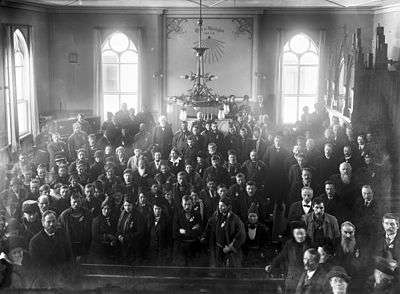
Credit: Schrøderarkivet/Sverresborg
The Sami assembly of 1917 was the first Sami national assembly. The Sami who took part in the assembly were from both Norway and Sweden. The meeting was held at the Methodist Church in Trondheim from 6 to 9 February 1917. The Sami National Day is celebrated on 6 February to commemorate the beginning of this assembly. Around 150 participants gathered at the assembly, of which the majority consisted of Southern Sami from Nordland, Trøndelag and Hedmark.
Elsa Laula Renberg (1877–1931) from Helgeland and the Sami Women's union at Brurskanken initiated the assembly. Renberg was the assembly's chairwoman and gave the opening speech at the meeting. The other great Sami leader at that time, Daniel Mortenson from Røros/Elgå, was also a chairman and gave a lecture at the assembly about reindeer farming and how it had become hampered by the Joint Sami Act ("Felleslappeloven") of 1883. The lecture sparked a debate that led to the forming of a separate committee concerning reindeer farming by the assembly. The committee later presented a proposal for a new reindeer farming act, which influenced the final shaping of the law in 1919. The other main issue at the assembly was the demand for a separate Sami school, where children were taught and allowed to write in the Sami language.
Background
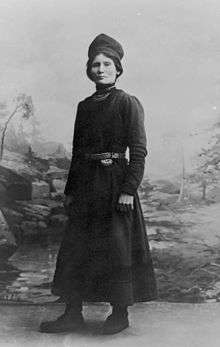
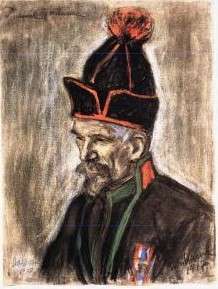
In the years preceding the assembly, Sami people in both Norway and Sweden felt that their culture and livelihoods were threatened. Therefore, in the years 1904-1910, both Sami organisations and journals started to arise.
Territory restrictions and Norwegianization
The Joint Sami Act of 1883 was the first major attempt by the authorities to "gain control of the Sami's reindeer herding".[1] The law applied to both Norway and Sweden, and established territories for reindeer grazing. The law introduced the principle of collective liability for all shareholders in the reindeer grazing territories for damages inflicted by the reindeer on the local agriculture. In 1894, the boundaries for reindeer grazing were established, yet important grazing areas such as Trollheimen and Gauldalsvidda fell outside these boundaries.[1] With the Supplementary Sami Act of 1897, landowners received the right to prohibit reindeer herding outside of the reindeer grazing territories. Prescriptive rights and common law were thus disregarded. However, the legal regulation of reindeer herding was in constant motion, and several commissions worked on the reindeer herding question up until the next reindeer herding act came in 1933.[2]
In Sweden, the "limit of cultivation" had given Sami nomads the right to use grazing land in the areas of the country that were situated above rural communities. These territories, however, were eventually adopted by new settlers, a process that has been characterized as "rural colonization", so that the reindeer herds were pushed away from the known grazing areas. The Sami's liability for reindeer damages remained however.
Questions of territory and grazing rights were particularly a problem in the Southern Sami areas. In the Northern Sami areas of Troms and Finnmark, the biggest challenge was Norwegianization, within "schools, industries, the church, defense and intelligence - often in a close (and intimate) relation". The pressure was particularly directed at Sami in "transitional districts" in coastal areas and remote fjords.[3][4] A part of this was due to the school governor not wanting Sami teachers to teach in Sami villages where they could "be to the detriment of their Sami knowledge"; they should therefore be sent to non-Sami villages.
Outside of Namsos, the Sami school in Havika had started in 1910 as a boarding school for children from Southern Sami families; the school was in many ways a "Norwegianization school",[5] but was also a meeting place for the Sami.[6] The Sami missionary organisation was founded in 1888, and from the beginning, made a conscious effort to use the Sami language. After national assembly resolutions in 1912 and 1913, the organisation adopted into its bylaws that "the organisation should in no respect be in violation of the State's work concerning the church and schooling". This was interpreted as supporting the Norwegianization effort.[7]
In Sweden, the authorities, through a school reform in 1913, had split Sami children into two groups, the so-called "category splitting": children of reindeer herding Sami went to "the Nomad school", whilst children of non-nomadic Sami went to regular schools, where they lost their Sami identity.[2] This was called "Lapps should be Lapps" politics, where "real Sami" were defined in a way that ostracized large groups of Sami.[8][9]
The question of reindeer herding across the border between Norway and Sweden had been a difficult topic during the Karlstad Convention.[10] From ancient times, the Sami reindeer herders placed little emphasis on national borders, and had let their reindeer graze in Sweden during the winter and in Norway during the summer. Through the Lapp Codicil of 1751, this tradition was regulated by contract between the countries.Eventually, as a majority of these Sami became Swedish citizens, grazing and reindeer herding rights from Sweden became a burden for Norway. During the negotiations of 1905, it was thought this cross-border reindeer herding included 80,000-100,000 Swedish reindeer in Troms and Nordland, and in comparison there were only 7000 Norwegian reindeer grazing in Sweden during the winter.[10] During the Karlstad Convention, this was finally resolved so that Norway accepted the grazing rights from Sweden, but was curtailed so that reindeer migration had to occur after June 15, six weeks later than previous regulations.
Lectures and discussions at the assembly
There were four key issues on the assembly schedule: reindeer grazing, legislation, schooling, and organisation issues. In addition, there was a lecture on tuberculosis, a slide show lecture by reindeer herding officer Kristian Nissen about "Sami and reindeer in Norway", and a historical lecture by "Headmaster Prytz" about the Røros Sami, emphasising the assault on the Sami at Dalbusjøen in 1811.[11][12]
The programme also included a civic reception, a dinner at the Trade Association, theatre visits, and a tour of the cathedral.
The assembly was conducted in Norwegian, partly due to Norwegian-speaking guests, and partly due to the difference between the Northern Sami and Southern Sami languages. Johan Roska apologised during the discussions that one could not use their own language at the assembly.
The question of reindeer herding
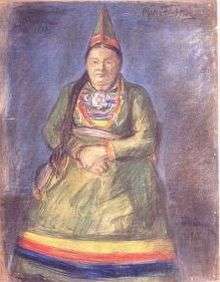
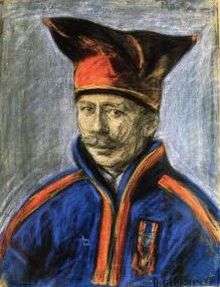
Mortenson held the lecture on reindeer herding.[13] The topic was discussed in relation to the "domestic relationships" and the "international (Norway/Sweden) relationships". The discussion on domestic relationships concerned first and foremost the loss of grazing land as a result of the farming of new land and other expansions in agriculture. Furthermore, grazing damages and compensation procedures for this were discussed, in addition to the distrust between the Sami and the farmers/villagers. Mortenson argued for a more business-orientated meat production in reindeer herding, with larger herds of reindeer. Renberg disagreed; she "maintained that the key condition is rational herding, whether it is about milking or producing meat".[14] "Allow those Sami who want to produce meat to do so, but also allow us with herds of approx. 100 reindeer the right to live according to the old Sami way of life". Mortenson was also concerned about a recent Supreme Court ruling on grazing rights and compensation in Røros that had gone against the Sami there.
The international relationships concerned the question of grazing across the border between Sweden and Norway.
The assembly agreed to a resolution where it was requested that the common law of free grazing would be maintained, and that the State had to buy or expropriate new grazing land to substitute grazing land that was now built upon. Changes in the rules concerning compensation for grazing damages caused by reindeer were demanded. They also wanted to changes to the rules regarding the sale of unmarked reindeer; such that the profits from this in the future could go to common Sami causes.
Lawyer Ole Tobias Olsen jr. from Mosjøen also attended the assembly and was active in the discussions about herding laws, in addition to that, he was one of the keynote speakers on the topic "legislation". Olsen had worked together with Renberg earlier, and was chosen as legal consultant to the committee that would work on the question of reindeer herding further. The others on the committee were Thomas Renberg (Elsa Laula Renberg's husband) and Nils Kappfjeld from Helgeland, Nils Andersen Nursfjeld and Per Larsen Jomafjeld from Nord-Trøndelag, and Johan Barrok and Mortenson from Sør-Trøndelag. This committee met again in Mosjøen a few weeks after the national assembly, and delivered in 1919, a separate proposal for a new reindeer herding law.
Legislation
Lawyer Olsen and the Swedish jurist Torkel Tomasson introduced the legal issues. Tomasson discussed the Joint Sami Act and highlighted several instances that "did not form a harmonious relationship with the Sami's interests"; he also said that the internal agricultural colonization "had deprived the Sami one right after another". He also criticised the provisions that regulated reindeer migration between Sweden and Norway, and thought that these were both contrary to the nature of the reindeer and common law.
Olsen discussed the rules concerning compensation for grazing damages caused by reindeer; the current practice was often that the damages were assessed with prejudice by the affected farmer's neighbours and friends. The same farmers and their friends also sat in on the full bench trial, thought Olsen. In the discussion after these lectures, the damages inflicted on reindeer by the villagers' stray dogs was also cited.
The discussion on herding and legislation were closely linked, and took up most of the time at the assembly. The resolutions dealt with these issues together.
Organisation issues
To initiate the establishment of a Sami organisation, Martin Tranmæl, former editor of the Trondheim newspaper Ny Tid, had been invited to the assembly. He recommended a structure with regional associations, municipal associations, and a nationwide association or a Scandinavian union.
Johan Roska from Nesseby advocated that a Sami newspaper should be started. He thought that it should be published in Norwegian, whilst Gunnar Johnsen Vesterfjeld from Helgeland thought that such a newspaper could be written in both Norwegian and Sami.
The committee formed to draw up a proposal for a new reindeer herding law were also asked to consider the organisation issue.
Schooling
A high priority during the assembly was the demand for a separate Sami school, and that children had to be taught in the Sami language. The issue was introduced by a lecture from the Swedish Nomad School-inspector, Vitalis Karnell, who gave an account of the new school system in Sweden. However, the assembly felt that this solution was not relevant in Norway. The discussion was otherwise marked by criticism of the Sami school in Havika, criticism that was concerned with both practical and principle questions.
After the common assembly was ended on Friday, and in line with the Friday discussions, a special meeting was held on Saturday 10 February concerning schooling.. Sanna Jonassen from Fosen/Namsos had initiated this meeting. The discussion concluded with a resolution that was attached to the minutes of the assembly. It was demanded that "the State should be obliged to provide Sami education while retaining the Sami language in the schools, with Sami overseers and teaching of such subjects, which are necessary for the Sami to know if they want to be able to exist as reindeer farmers".[15] The resolution points out that this should be arranged in different ways in Southern Sami and Northern Sami regions, given that in Southern Sami areas, the Sami kept on settling down there.It was also felt that it was the State, and not the Sami missionary organisation, that should have responsibility for education.
Two factions during the assembly
An impression that there were "two factions" during the assembly has attached itself to the meeting, an impression that was established in Adresse Newspaper's report from the assembly in the same week. Later historiography has alternated between minimizing this point, and highlighting it.
Mortenson and Renberg were regarded as leaders of each faction. The two had experiences of different forms of reindeer farming. In Røros, Mortenson had already in 1902 begun to shift from intensive reindeer herding nomadism to extensive meat production. Renberg's grazing district in Helgeland belonged to the part of Southern Sami reindeer herders who were the last to give up the close nomadic life with the reindeer. Mortenson argued for a modernization of reindeer herding. "Thus, there were representatives of two different herding methods that met, with somewhat contrasting interests in relation to what they wanted to achieve with regard to the revision of the reindeer herding laws. Mortenson wanted reindeer husbandry to be integrated into Norwegian society and wanted a law that would fit accordingly. Renberg was deeply rooted in the traditional, nomadic reindeer herding and was keen to preserve Sami values and traditions".[13]
Mortenson was not concerned with Sami education in schools either. Renberg had a starkly contrasting view. This view has been described as a "special demand" from Renberg's side, and a "general demand" from Mortenson's side. It was clear during the assembly that government representatives preferred general, unspecified demands. Nissen succeeded in rejecting a draft resolution from the two Finnmark Sami on the grounds that it concerned "special interests".
Notes
- 1 2 Severinsen, Anna (1979). "Opprettelse av reinbeitedistrikt i Sør-Norge : overgrep eller tilrettelegging?". Ottar. No. 116–117. pp. 38–54.
- 1 2 Jernsletten (1991)
- ↑ Otnes 1970; p. 129
- ↑ Sandøy, Ragnhild. "Fornorsking av Finnmark blei deres liv: Samiske lærerpionerer fra Tanafjorden". In Girji, Davvi. Samisk skolehistorie 4 (in Norwegian).
- ↑ Lund, Svein (2003). Samisk skole eller Norsk Standard?: Reformene i det norsk skoleverket og samisk opplæring (PDF). Karasjok, Norway: Davvi Girji.
- ↑ Aarseth, Bjørn. "Internatet som sosialt bygdesentrum". In Girji, Davvi. Samisk skolehistorie 1 (in Norwegian).
- ↑ Borgen (1997), p. 11–25
- ↑ Solbakk, John Trygve; Solbakk, Aage (1999). Dasgo eallin gáibida min soahtái ja mii boahtit – mii boahtit dállán!/Selve livet kalder os til kamp og vi kommer – vi kommer straks!. Karasjok, Norway: Čálliidlágádus. ISBN 82-92044-00-0.
- ↑ Asplund, Roland. "Nomadskoleboken". Svenska kyrkan (in Swedish).
- 1 2 Bull, Kirsti Strøm (2005). "Reindriftssamene og 1905". Plan. 3–4.
- ↑ Løøv, Anders (1994). "En samisk sitje går under på Gauldalsvidda år 1811". Festskrift til Ørnulv Vorren. Tromsø, Norway: Tromsø Museum. ISBN 8271420178.
- ↑ Jan H. (19 March 2011). "Et samisk samfunn går under på Gauldalsvidda". Samernes Historie (in Norwegian).
- 1 2 Berg, Bård A. (1994). Reindriftsloven av 1933: Om den først reindriftsloven som omfattet hele Norge: Bakgrunn, forhistorie, og innhold (in Norwegian). Kautokeino, Norway: Sámi Instituhtta.
- ↑ Dagsposten i daglige reportasjoner 6.-10. februar 1917; gjengitt hos Borgen 1997
- ↑ "Protokoll Norske lappers..." (1991)
References
- Borgen, Peder (1997). Samenes første landsmøte: 6.-9. februar 1917 : grunnlaget for samefolkets dag 6. februar. Trondheim, Norway: Tapir. ISBN 82-519-1249-0.
- Braseth, Leif (2014). Samer sør for midnattssola, sørsamenes historie, kultur og levemåte. Bergen, Norway: Fagbokforlaget. ISBN 978-82-450-1718-2. . Sami assembly discussed in chapter «Landsmøter i en mørk periode», pp. 368–386
- Jernsletten, Regnor (1991). "Trondheimslandsmøtet 1917 og samebevegelsen". Åarjel-saemieh. Snåsa, Norway: Saemien sijte. 4: 75–81. Archived from the original on 2007-05-15.
- Jernsletten, Regnor (1998). Samebevegelsen i Norge: idé og strategi 1900-1940. Tromsø, Norway: Senter for samiske studier, Universitetet i Tromsø.
- Johansen, Siri Broch (2015). Elsa Laula Renberg. Karasjok, Norway: CálliidLágádus. ISBN 978-82-8263-171-6.
- Otnes, Per (1970). Den samiske nasjon: interesseorganisasjoner i samenes politiske historie. Oslo, Norway: Pax.
- Pareli, Leif (1988). "Det første samiske landsmøtet – Trondheim 1917". Åarjel-saemieh. Snåsa, Norway: Saemien sijte. 3: 103–116.
- "Protokoll Norske lappers 1ste landsmøte avholdt i Trondhjem 6.-9. februar 1917". Åarjel-saemieh. Snåsa, Norway: Saemien sijte. 4: 82–88. 1991.
- Salvesen, Helge (1979). "Makt og avmakt i samisk historie. Politisk organisering blant sørsamane rundt hundreårsskiftet". In Stemshaug, Ole. Årbok for Trøndelag 1979. Trondheim, Norway: Trønderlaget.
- Wuolab, Anne (2007). Forfatteren Elsa Laula og boka 'Inför lif eller död?. Åarjel-saemieh. 9. Snåsa, Norway: Saemien sijte. pp. 67–78.
External links
| Wikimedia Commons has media related to Samemøtet 1917. |
- Tråante 2017 official site
- "Samane si politiske organisering på 1900-talet", Norgeshistorie.no (in Norwegian)
- "Hundreårsjubileum for samenes første landsmøte", Norgeshistorie.no (in Norwegian)
- "Samenes første landsmøte 1917", Saemien Sijte, via digitaltmuseum.no (in Norwegian)
- "Protokoll for "De norske lappers 1ste landsmøte"", Tromsø Museum (in Norwegian)